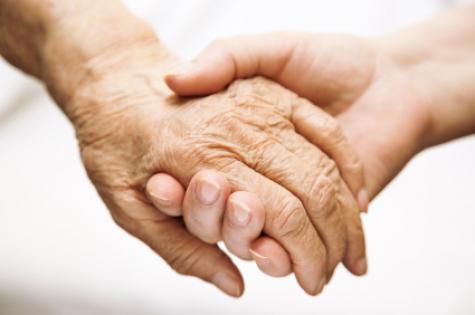I am going to tell you some stories and they are all true (although I am not using real names). It could be any hospital in any city. You might be shocked or offended or surprised - but you shouldn’t be because these stories are about dying; and death, like life, is full of surprises.
As doctors it is a privilege to care for dying patients.
It is a constant reminder to us that we share the same ultimate destiny; that even our most sophisticated treatments and advanced knowledge have limitations; that we can always do better; and each person we care for has something to teach us.
Edith lived in high level residential care where she had help with washing, dressing, eating and getting around. She had a stroke a couple of years ago and had difficulty finding the exact words for certain things and she had to have a special diet of soft food because things sometimes went down the wrong way. She was on lots of tablets but not on any painkillers. She had lovely grandchildren who dropped by from time-to-time with her daughter Robyn. One evening Edith started to choke on some mashed potato. She got very short of breath and stopped breathing which caused her heart to stop. She lost consciousness and fell to the ground. Her carer called the nurse who started CPR (heart massage) the moment she arrived and also called the ambulance. The paramedics with the ambulance did a wonderful job: they got her breathing again and got her heart started. On arrival at hospital, she was admitted to the intensive care unit and put on life support until her family could be contacted and come to be with her.
Edith’s daughter Robyn rushed straight to the hospital and was very surprised and distressed to hear what had happened to her mother. The doctors said it was too early to tell how she would go and that they would know more after a few hours and they had done some tests. A brain scan showed brain swelling due to lack of oxygen and, by the following morning, Edith was having frequent seizures. She was given intravenous anti-seizure medications and her prognosis explained to Robyn. Robyn felt Edith needed to have more of a chance to get better and she did not want to make any decisions without her husband who was overseas and would be back in 5 or 6 days. Edith’s seizures did not respond to drugs and other treatments for brain swelling, and she needed life support. When Robyn’s husband got home, her family said their goodbyes and Edith passed away. Robyn was really angry with the doctors; one had said that Edith should not have been resuscitated in the nursing home and brought to hospital, because what had happened to her was very predictable.
Fred lives in a similar facility to Edith. He used to be in low level care with his wife. But after she died earlier in the year, Fred fell, broke his hip and was transferred to high level care following hospital treatment. Fred has been distraught since his wife passed way. He misses her terribly and when he came back from hospital following his hip surgery, he had been saying he wants to be with her. He kept asking for painkillers because his hip was still very painful, he doesn’t want to get out of bed and refuses to let the physiotherapist anywhere near him. At age 80, he said he has had “enough”.
After a while, Fred started to get confused and short of breath, then drowsy. His GP saw him and felt he should be kept comfortable and stay in the nursing home but in the night he could not be roused. His records did not contain any information about end of life choices and Fred was sent to hospital by ambulance where he had a breathing tube put in to his lungs and was started on strong antibiotics and placed on life support. After a few days, his niece Anne, who was his next of kin and lived in the country, came to see him. Anne was surprised to hear what a good response to treatment Fred was having: he was off life support and he was to be transferred to a regular ward. He had been started on long acting painkillers for his hip as well as antidepressants and was feeling much better after getting out of bed. Fred went to convalescent care and rehabilitation before returning to the nursing home where he is in low level care again. He has now written an advanced care directive and does not wish to have life support in the future.
Ray was living at home. He was doing really well, even though he is 83, and having treatment for lung cancer. He was still able to walk Vinnie, his Jack Russell, every day. One evening, Ray suddenly got short of breath and called the locum who said he had a fever and sent him to hospital. His oxygen levels were really low, even though he didn’t feel too bad, so he was admitted to the intensive care unit where he was given strong intravenous antibiotics. Blood tests showed his immune system wasn’t working very well so he was started on a drug to boost his blood count. Initially he seemed to respond to the antibiotics but then his oxygen levels fell a bit more and he needed a tight fitting face mask which pushed oxygen into his lungs. The mask was pretty comfortable and he had a sleep but, after six hours, his face got a bit sore. The doctors said his X-ray was worse and his kidneys were failing and he might need dialysis. Ray told his sons and his grandchildren that he did not want to have any more treatment because the doctors told him his chances of getting better were very slim. They felt this was the case because of the type of cancer he had, the fact that his blood count was low and that he was getting worse even though he had antibiotics. Ray decided to have medications for pain and anxiety and to have oxygen; but not dialysis, a breathing machine or any other life support. He died after 3 days in hospital with his family by his side. He gave Vinnie to Andrea, his 10 year old granddaughter because she was Vinnie’s favourite.
Bradley was a child with severe cerebral palsy who came to our ICU many times over the years with pneumonia. Each time he would be treated with antibiotics and a breathing machine; sometimes he would get better in a week, sometimes in 4 or 5 weeks. His parents would take him home and we would not see him for six months or a year, sometimes even as long as two years. As he grew, his dad could no longer lift him and we helped him get a van and a hoist to bring his son to appointments and to get around. After ten years of regular treatment with us, Bradley had his final illness and passed away at age 16. He had slowly deteriorated over the previous two years, spending more and more time in hospital, and his family decided not to continue with treatments that were not working. It was a very sad time for his parents, brothers, sisters, grandparents and us - but it was the right time for Bradley.
I have so many stories like these which show the numerous possible ways the end of our days can take us and those who love and care for us by surprise. It is not scripted or planned yet we must be able to rely on the kindness, understanding, judgement and most of all the competence of health professionals when we need them most even if we can’t be cured. Will I know when my time comes? Can doctors predict the end?
Palliative care is a multidisciplinary team based approach to patient care which focuses on the alleviation of pain and suffering and the avoidance of uncomfortable symptoms such as nausea, breathlessness, itching and constipation which can be brought on by illness or medications. It is a proactive thoughtful approach which individualises treatment for each patient and uses the skills and expertise of all available health professionals. There are of course specialists in palliative care who can be called upon to help manage complex patients, advise colleagues or lead teams who care for patients during the terminal phase of a final illness. Palliative care is not incompatible with active treatment of chronic debilitating or irreversible conditions and has been demonstrated to prolong and improve survival. It is not necessarily an exclusive choice but for many it can be a difficult one.
Although at least 85% of patients in the intensive care unit get better, the remainder do not. A significant percentage of patients who survive critical illness will need palliative care input, which is part of my job. The challenge for doctors like me is to know who is ready for palliative care - physically, emotionally, spiritually, physiologically. This is not an easy question to answer and it is only by either clear directives from patients about what are acceptable health outcomes, or testing the clinical circumstances in which an individual finds themselves, that we can come to any conclusion.
Many patients with chronic progressive debilitating diseases have intermittent crises from which they recover and regain their previous quality of life. Many patients with sudden traumatic injuries survive and exceed the expectations of their caregivers and physicians but many do not.
Treating an individual’s illness quickly and accurately is part of the process of recognising those who are at the end and those who are near the end. Age is not necessarily a guide as three quarters of patients over 85 years old admitted to our Intensive Care Unit survive their critical illness. It takes experience and confidence to apply intensive care treatment; recognise if they are not working and then accepting that a palliative pathway is the treatment of choice.
The question of who will benefit from the involvement of a palliative care specialist is very important. These doctors and nurses have great expertise and skill and improve the experiences of patients and their loved ones.
















__small.png)










